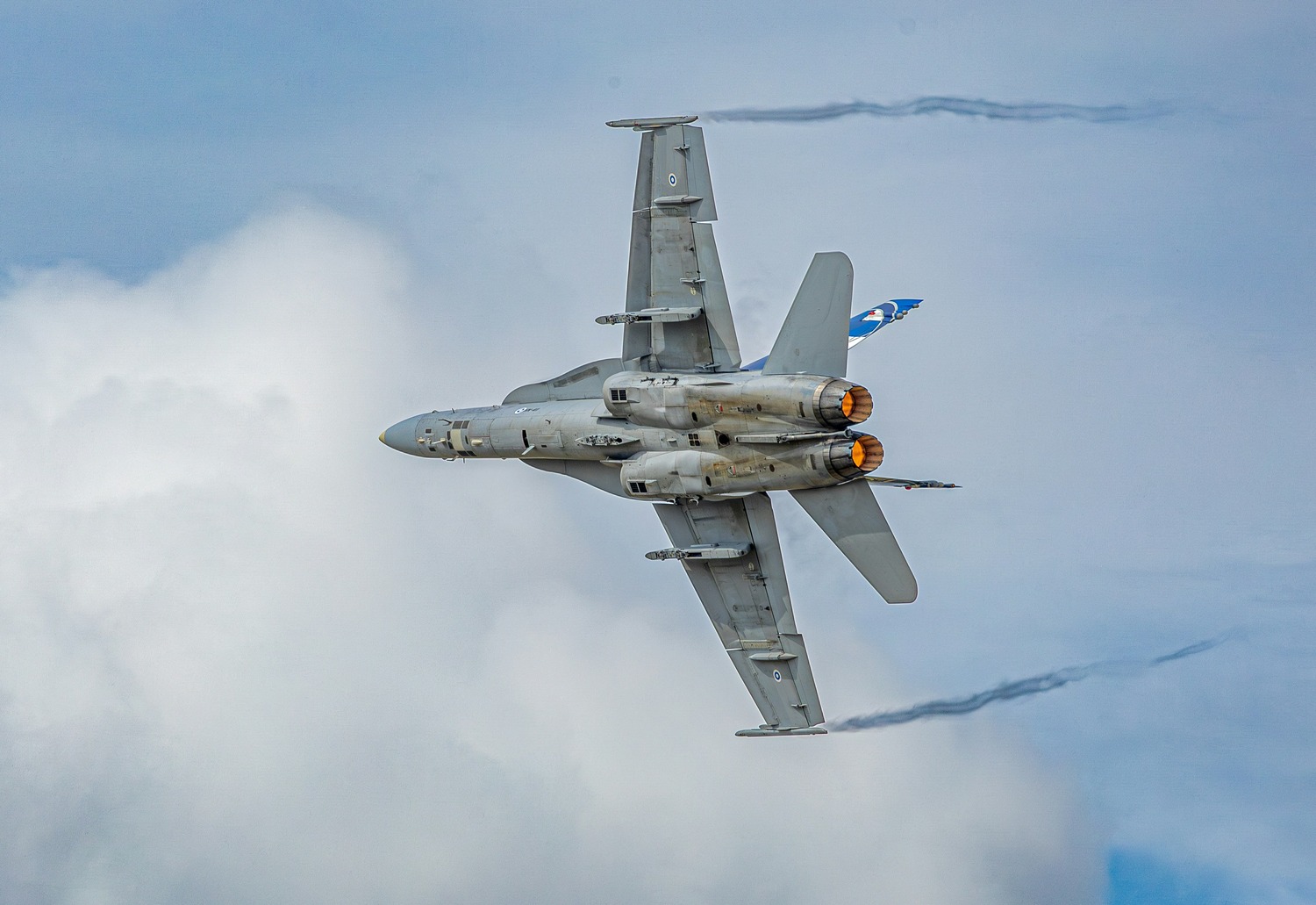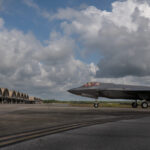The Royal Australian Air Force keeps 41 de-commissioned F/A-18A/B Hornets in climate-controlled hangars at RAAF Base Williamtown. Canberra, Washington, and Kyiv are now in formal talks that could move a portion of that fleet to Ukraine instead of a scrapyard.
Australia retired the “Classic Hornet” line in late 2021 after 36 years of frontline work. The jets logged modest flight hours and never faced the corrosive salt spray that carriers inflict, so airframes remain sound. Defense planners say a focused overhaul – new fuel cells, updated avionics cards, and a software refresh – could have the first aircraft mission-ready in under four months.
Washington holds the intellectual property keys, so the U.S. State Department approval controls the pace. Kyiv has assured the White House that the aircraft would not be deployed into Russian airspace. That hurdle looks lower since President Biden signaled support for fourth-generation transfers during the G-7 summit in May. U.S. diplomats have passed Canberra a provisional nod, provided end-use restrictions keep the jets inside Ukrainian airspace.
Ukrainian air-defense gaps show each night on satellite streak plots. Kyiv’s own pilots still fly aging Soviet jets, and spare parts arrive irregularly. A dozen Hornets with AIM-120 stocks would blunt cruise missile raids against smaller cities that sit beyond Patriot coverage. Twin engines increase pilot survival odds if a missile clips a nozzle; Ukraine cannot afford dead crews.
Australian officials weigh two competing disposal tracks:
- Option 1: Donation to Ukraine – Canberra covers overhaul, ships spares, and trains pilots abroad.
- Option 2: Commercial sale – U.S. firm RAVN Aerospace wants the airframes for “red-air” training sorties.
A 2020 letter of intent promised 46 jets to RAVN, but the contract lapsed in December 2023 without one ferry flight. Cabinet sources call that a “fortunate pause” that leaves room for Ukraine.
Security analyst Robert Potter, who advises Kyiv, speaks plainly: “Australia sits on useful hardware that Russia would rather see scrapped.” He counts at least 28 Hornets in flyable condition after quick depot checks. A further handful could serve as spare donors.
Logistics planners outline a tight schedule: ship eight containers of tooling, load technical data onto rugged laptops, ship weapon pylons and ejection seats, and then start cockpit conversions from English to Ukrainian language packs. Experienced RAAF maintainers would deploy to Poland, not Ukraine, and hand tools to local crews at a neutral airfield. Similar overseas technical support models have been used in Ukrainian training programs.
The U.S. Air National Guard’s 162nd Wing in Arizona already trains foreign F-16 pilots. A similar syllabus for Hornet transition could run at the same base, condensing classroom work to three weeks and flight work to seven. Canberra distances itself from that detail but Defence sources confirm the plan exists on paper.
Hornets deliver more than air defense. The jet’s APG-73 radar pairs with AGM-88 anti-radiation missiles to hunt S-300 batteries, and the jet’s centerline station fits an AN/AAQ-28 Litening pod for precision day-night strikes. Ukrainian engineers already integrated the U.S. JDAM-ER kits on Soviet fighters; adding them to Hornets would run quicker because the weapons are native.
Risk of escalation sits high on the brief. Australian strategists advise a written caveat: if a Hornet crosses Russia’s border with ordnance, support ceases. Canberra used the same clause for Bushmaster APCs shipped in 2022.
Politics play both ways. Giving fast jets would prove Australia can give weighty assets while it asks the U.S. for nuclear-powered submarines. It would also cushion criticism over the scrapping of still-serviceable planes during a regional arms race. Defense insiders hint the next aid tranche, due before Parliament’s winter break, could include a first batch of Hornets plus AIM-120C-5 stocks.
What the Hornets add immediately:
- Speed of integration – Western-built jets need no reverse engineering.
- Common missiles – Ukraine already receives AMRAAM rounds for NASAMS launchers.
- Durability – Twin-engine design lets damaged jets limp home.
- Short-runway tolerance – Robust landing gear copes with rough Ukrainian strips.
Steps before a first combat patrol:
- Drain and borescope fuel tanks.
- Replace rubber fuel cells, hoses, and seals.
- Upload fresh mission-computer software.
- Check ejection-seat cartridges.
- Test-fly each jet under RAAF supervision.
Critics warn of sustainment drag. Hornets pull distinct spare lines and different ground-support gear than the F-16s Kyiv also expects. Ukrainian planners reply that any modern fighter beats none, and the overlap lasts only until F-16 numbers climb.
Canberra must also weigh domestic fleet recapitalization. RAAF Super Hornets shoulder more tasking since Classic Hornets left service. Losing depot-bound airframes poses little operational impact, but engineers who keep them airworthy now work on Growlers. Defense’s Materiel Branch insists heavy-maintenance slots exist.
Inside Parliament, opposition back-bencher Andrew Hastie urges quick action, saying, “We promised to back rules-based order with hardware.” A bipartisan petition on Change.org passed 180,000 signatures in three days.
Ukraine’s ambassador Vasyl Myroshnychenko stays cautious. He tells reporters his air force “will welcome any aircraft that arrive on time and in useful quantity,” yet he stresses focus on F-16 integration first.
Analysts outline three decision paths now before Canberra:
- Green light – Approve donation of 28 flyable Hornets and spares.
- Partial release – Offer 14 airframes judged best by inspectors and keep the rest for parts.
- Final sale – Re-sign with RAVN and exit the debate.
Defense will brief the National Security Committee next month. A senior official sums up: “The jets either fight or rust. We choose.”
WHAT’S NEW – March 2025
Talks froze in early 2024 when Kyiv prioritized F-16 induction and Canberra focused on its AUKUS submarine program. No Hornet crossed the equator. The vacuum gave critics room to claim the project had died.
The file reopened in February 2025 after Ukraine logged its seventeenth straight month of missile raids and appealed for a stop-gap interceptor. Deputy Prime Minister Richard Marles used the Avalon Airshow press pit on 27 March to confirm Cabinet “will reconsider the Classic Hornet option within weeks.”
Behind the curtain, Defense retained 14 airframes in “flyable storage” despite rumors of scrapping. Engineers spun each engine to slow corrosion, and sealed cockpits stand ready for instrument-power checks. A small Ukrainian delegation toured Williamtown in January. They ran cockpit fit checks with Cyrillic overlays and were satisfied that conversion was feasible without ripping out core avionics.
The U.S. State Department has refreshed its letter of offer, valid to year-end, so Canberra can still move the jets under Foreign Military Sales channels at no extra paperwork cost. Washington’s only new caveat bars any anti-ship payload; planners believe the clause answers Kremlin complaints over Black Sea security. This aligns with Ukraine’s urgent need for advanced defense systems.
RAVN Aerospace remains interested but shifted its emphasis to ex-Spanish Mirage F1s last autumn. The company now wants only six Hornets for tests. That change reduces domestic resistance to a larger military transfer.
Australia’s treasury penciled A$230 million to strip sensitive U.S. code and package spare parts. The figure matches the cost of scrapping and toxic-material disposal already budgeted, which makes a donation cost-neutral on paper.
Kyiv signaled acceptance of a mixed fleet. It captured Russian Sukhois, leased Swedish Gripens for training, and soon its first operational F-16 block landed at Myrhorod. Ukrainian air staff say two squadrons of Hornets would defend the south while F-16s handle strike work in the east.
Public opinion swung again after March’s temporary cease-fire collapsed when Russian drones hit Odessa grain terminals. Social feeds in Australia are filled with calls to “use the jets or lose them.” That momentum frames the next Security Committee meeting, now set for 3 April 2025.
If ministers approve, planners will follow a three-node lift:
- Break each jet down at Williamtown.
- Ship modules by air to Rzeszów, Poland.
- Reassemble and flight-test there under joint RAAF-UkrAF teams.
RAAF veterans volunteer to instruct. Some flew Hornets in Afghanistan and crave one last cockpit tour. Defense medical screens start next week.
The final decision rests with Prime Minister Anthony Albanese. His office leaks nothing, yet senior aides hint the Cabinet wants a signature gesture before national elections in August. Sending aircraft that would otherwise rot ticks that box without cutting active RAAF strength.
Ukraine awaits word. Pilots keep current on MiG-29s, studying Hornet procedures on laptop simulators coded in Warsaw. An instructor says, “We train now, so we fly on day one if Australia calls.”
REFERENCE SOURCES
- https://www.flightglobal.com/fixed-wing/raaf-marks-15-years-since-delivery-of-the-first-super-hornet/162365.article
- https://www.afr.com/world/europe/australia-the-us-and-ukraine-are-discussing-sending-41-raaf-fa-18-hornets-to-ukraine-20230606-p5ddkt
- https://www.abc.net.au/news/2023-06-08/retired-australian-jets-step-closer-to-joining-ukraine-war/102452394
- https://www.aviacionline.com/2023/06/australian-f-a-18-hornet-fighters-could-be-transferred-to-ukraine/
- https://www.globaldefensecorp.com/2023/06/07/u-s-and-australia-plan-to-send-41-retired-raafs-f-a-18-hornets-to-ukraine
- https://alert5.com/2023/06/28/14-of-raafs-retired-classic-hornets-are-suitable-to-be-donated-to-ukraine/
- https://armyrecognition.com/news/aerospace-news/2023/ukraine-air-force-to-possibly-receive-41-decommissioned-royal-australian-air-force-f-a-18-hornets
- https://www.defenceconnect.com.au/air/12694-public-petition-formed-to-send-classic-hornets-to-ukraine
- https://www.globaldefensecorp.com/2023/07/14/australia-cannot-deliver-f-a-18-hornet-aircraft-to-ukraine-until-2024/
- https://www.australiandefence.com.au/news/news/australian-jdam-ers-sent-to-ukraine



